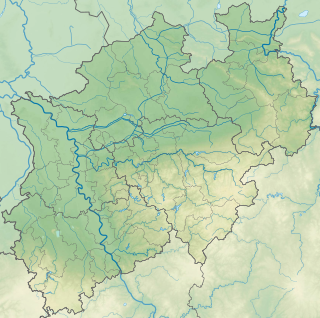Düsseltal estuary
| Düsseltal estuary | |||
|---|---|---|---|
| Düssel at the exit of the Neanderthal | |||
| Systematics according to | Handbook of the natural spatial structure of Germany | ||
| Greater region 1st order | North German Lowlands | ||
| Greater region 2nd order | Lower Rhine lowlands and Cologne Bay | ||
| Main unit group | 55 → Lower Rhine Bay |
||
| About main unit | 550 → Bergische Heideterrasse |
||
| 4th order region (main unit) |
550.1 → Hilden-Lintorfer sand terraces |
||
| Natural space |
550.13 → Dusseldorf mouth |
||
| Geographical location | |||
| Coordinates | 51 ° 13 '6 " N , 6 ° 54' 47" E | ||
|
|||
| local community | Erkrath | ||
| state | North Rhine-Westphalia | ||
| Country | Germany | ||
The Düsseltal estuary is a small-scale natural unit with the order number 550.13 and belongs to the higher-level natural main unit 550.1 ( Hilden-Lintorfer sand terraces ). It is part of the Bergische Heideterrasse .
According to the Handbook of Natural Spatial Structure of Germany, the Düsseldorf estuary includes the end of the Düssel valley emerging from the Rhenish Slate Mountains in the transition to the Rhine plain between the Neandertal and Düsseldorf - Gerresheim , but not the area where the river actually flows into the Rhine . In the north, east and south the Düsseldorf estuary is enclosed by the Mettmanner Loessterrassen (337 1 .00), in the west the natural area borders on the Düsseldorf-Duisburg Rhine plain (575.30). Alt-Erkrath, the city center of the city of Erkrath, is located in the natural area, almost completely filling it .
The box valley of the Düssel in the natural area is approx. 3.5 km long and approx. 500 m wide. The depression of the valley floor within the terraced area on both sides of the Rhenish main terrace is around 50 m deep and extends to the Oligocene sea sand. The valley floor consists of alluvial sanded low terrace gravel and sand on which the Düssel meanders. Remnants of the middle terrace have been preserved in the outskirts of the Düsseltal.

